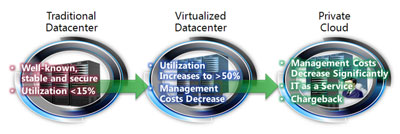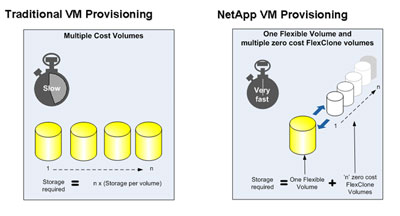There's been a lot of discussion of cloud technology over the last year or so, including numerous articles in this newsletter (see sidebar), but very little in the way of tangible steps that you can follow for cloud deployment.
NetApp has been collaborating with Microsoft to develop integrated technologies that simplify the process of cloud deployment. If you've already moved from a traditional data center model to a virtualized data center, the next logical step might be a private cloud. The main thing that differentiates a private cloud from a virtualized data center is a management layer that allows you to treat your IT infrastructure as a pool of resources from which users or business units can request and receive resources automatically.
Figure 1) Data center evolution.*
Until now, solutions to accomplish the automation step have required a lot of custom work. Microsoft is streamlining the automation process with its Dynamic Datacenter Toolkit (DDTK)*. This toolkit lets you quickly and easily incorporate all the processes you would use during a manual deployment of a virtual machine into the automation. NetApp has been collaborating with Microsoft to make sure that NetApp® storage integrates with the DDTK framework, allowing you to take advantage of NetApp cloning and other capabilities during automated provisioning.
Private Cloud Building Blocks
When we talk about a private cloud, we mean a cloud designed to meet your internal IT needs: a means to deliver IT as a service (ITaaS) to your internal customers. In practice, you might evolve your existing virtualized infrastructure into a private cloud, or you might supplement your existing infrastructure with a private cloud deployment.
Figure 2) Cloud definitions.
The building blocks for an internal cloud are in large part the same as for any virtualized infrastructure. A virtual infrastructure based on Microsoft® and NetApp would consist of:
- Scalable servers with enough network interfaces and memory
- NetApp shared storage
- A network infrastructure adequate to support high storage utilization
- Microsoft Hyper-V™ for server virtualization (You can read about best practices for deploying Hyper-V on NetApp storage in a recent Tech OnTap article.)
- System Center Operations Manager (SCOM) and System Center Virtual Machine Manager (SCVMM) for management
If you have all these pieces in place, all that remains is the ability to provide customer onboarding, dynamic provisioning, and self-service, which I'll talk more about in the following section.
If you haven't fully virtualized, you can begin preparing now for private cloud deployment by:
- Ramping up your virtualization efforts and expertise
- Standardizing on scalable server hardware
- Standardizing on a management platform for both physical and virtual machines
- Fine tuning your processes to minimize interactions between staff and infrastructure
- Beginning to architect your IT services for shared compute resource pools
Cloud Automation with DDTK
The Microsoft Dynamic Datacenter Toolkit extends the ability of SCOM and SCVMM to manage virtualized environments with the automation needed to turn the building blocks made possible by virtualized infrastructure into a private cloud.
DDTK is a turnkey solution that works with SCOM and SCVMM to provide:
- Customer/business unit onboarding
- Automation and guidance
- Dynamic provisioning
- Self-service portal
- Batch creation of VMs
DDTK WorkFlow
The best way to understand how DDTK simplifies virtual infrastructure deployment is to look at a typical process flow for a new customer or business unit. DDTK includes an onboarding wizard that guides a user through the process of registering his or her business unit. A separate wizard captures the requirements of the new IT service in an infrastructure request. While this infrastructure request obviously requires some prior thought, the wizard does a good job of guiding the user and defining the possible choices. The self-service portal allows designated individuals to configure virtual machines within the infrastructure once the infrastructure request has been approved (subject to the limits defined by the request).
Figure 3) DDTK process flow for a new infrastructure user. Approval
process makes sure you retain enough oversight
of your infrastructure.
The registration process captures the name of the business unit, the priority of the request, the justification for the request, administrators who will have access to the infrastructure, and a business unit code that can be used for chargeback or other purposes. Once a request has been entered, you can review and accept or deny it.
Once the registration has been accepted, the user can then create an infrastructure request, which defines required memory, storage capacity, networking, VM templates to be used, additional codes for chargeback, and so on. The user also has the ability to create multiple services as part of the infrastructure request-such as development, test, and production-with quotas assigned to each service.
After an infrastructure request is submitted, you once again have the opportunity to review the request and make any adjustments to the request if necessary. This review process helps prevent any business unit from grabbing too many resources either accidentally or on purpose.
Finally, when the infrastructure request has been approved, the user (or designated administrator) then uses the self-service portal (SSP) to submit VM creation requests and configure VMs to meet their specific needs. The DDTK provisioning engine translates these requests to SCVMM, and they are performed automatically with step-by-step notification to the user or application owner.
DDTK Configuration and Partner Integration
To make it easy to get DDTK up and running, the toolkit includes a variety of default settings and scripts that can be used as is or modified using a wizard-driven interface. This makes it simple to extend your cloud environment to include third-party products. It also makes it easy for third-party vendors to provide integration for their own products, which allows you to take full advantage of value-added features.
NetApp has been working closely with Microsoft to provide this integration for our joint customers. The DDTK provisioning engine is able to call NetApp PowerShell cmdlets and scripts directly to carry out specific storage activities.
For instance, it's well known that the standard virtual machine provisioning process results in a lot of duplicate data-copies of the same operating system and application files might be provided for each virtual machine. NetApp integration allows you to eliminate this storage overhead and accelerate the provisioning process using NetApp FlexClone® technology. Instead of making full copies, FlexClone allows multiple VMs to share blocks that are identical. A FlexClone volume only consumes additional storage space as blocks are modified or new blocks are changed. This makes the process very fast and very space efficient.
Figure 4) DDTK provides easy integration that allows traditional VM
provisioning to be replaced with a fast, efficient process
that uses NetApp FlexClone technology.
This functionality will be provided as part of NetApp ApplianceWatch™ PRO 2.1, which will available to NetApp customers free of charge on the NetApp NOW™ Web site in the summer of 2010.
Learning More
The DDTK is undergoing beta testing now and will be generally available soon. If you want to learn more about this technology, you have a number of options:
- A recent Microsoft TechNet webcast describes the technology, including NetApp integration, and includes three demonstrations that illustrate the interfaces.
- Technology from both partners was shown at the recent Microsoft Management Summit and will be demonstrated again at the upcoming TechEd 2010 conference in New Orleans, Louisiana, June 7-10.
*Figure 1 and information about DDTK (formerly referred to as Dynamic Infrastructure Toolkit for System Center) were adapted with permission from the February 25, 2010, TechNet Webcast, Dynamic Infrastructure ToolKit for System Center Deployment: Scenario Walkthrough (Level 300), by Ananthanarayan Sundaram, senior product manager, Virtualization Marketing, Microsoft Corporation, with Suveen Kumar Reddy Vuppala, senior SDE, Solutions Accelerator team, Microsoft Corporation. You can view the full presentation by clicking the hyperlink above.







